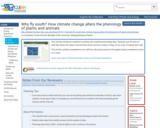
The purpose of this resource is to classify and count the reproductive phenological phases of receptacles on selected seaweed species. Students will classify and count the reproductive phases of seaweed plants within a 1-meter x 1-meter plot in the inter-tidal zone.
- Subject:
- Applied Science
- Ecology
- Environmental Science
- Life Science
- Material Type:
- Activity/Lab
- Homework/Assignment
- Interactive
- Lesson Plan
- Teaching/Learning Strategy
- Provider:
- UCAR Staff
- Provider Set:
- GLOBE Teacher's Guide NGSS Aligned Records
- Author:
- The GLOBE Program, University Corporation for Atmospheric Research (UCAR)
- Date Added:
- 01/09/2007

